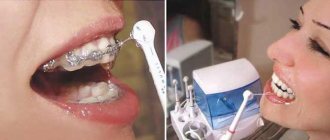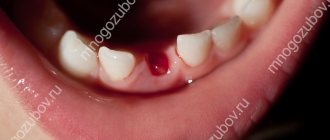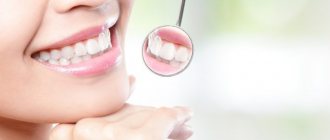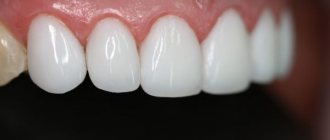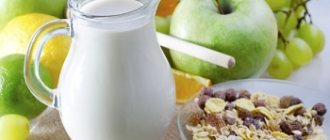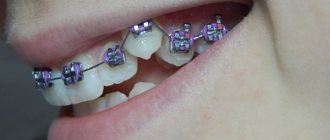Ways to quickly whiten teeth
A snow-white smile is a sign of health and success. The owner of such a treasure feels confident in the company of friends, colleagues, and strangers. Unfortunately, not everyone has naturally white teeth, and over time, tooth enamel becomes dull and acquires a yellowish tint.
The reasons for tooth discoloration are: age, food, bad habits, chronic diseases. As we age, dentin becomes thinner and, as a result, the tooth tissue darkens. Many products contain dyes that affect the color of tooth enamel: carbonated sweet drinks, coffee, tea, red wines. Tobacco gives dentin its yellow color.
There are many ways to quickly whiten teeth, the main ones being:
- intensive whitening - performed by a dentist;
- whitening preparations - using special products yourself;
- whitening pastes;
- folk remedies.
Intensive whitening
Intensive whitening is a professional method and is carried out only by a specialist in a dental clinic. Among professional whitening methods, this is the most popular because it is the fastest.
The method is based on the use of a brightening gel . The gel contains oxygen. The substance is applied to the teeth. During the procedure, special measures are taken to protect the gums.
The drug should not get on the gum tissue. A beam of bright light is then directed onto the gel. Light causes a chemical reaction, oxygen becomes active and perfectly whitens tooth enamel.
The procedure takes about 60 minutes.
Does IQOS affect the color of teeth?
IQOS is an innovative product, which means that not all adult users are aware of its features.
However, many studies have been conducted in which scientists studied the effects of IQOS on the body. In order to introduce users to information about the device, a webinar was held with the participation of Dmitry Ulupov, Director of Research and Development at Philip Morris International (PMI) in Russia, and Maxim Kopylov, a dental surgeon, periodontist, and founder of the MaxTreat periodontal center. In this article we have briefly collected the most important things from the webinar.
IQOS scientific webinar “What is the connection between a smile and IQOS?”
What is IQOS?
IQOS is an innovative tobacco heating system. HeatControl™ technology, on which IQOS operates, does not allow the temperature inside the device to rise above 350°C.
Thanks to this, when using IQOS, the levels of harmful substances released are on average 95% lower compared to cigarettes*. Scientists, engineers and other employees of the PMI Research and Development Center have been developing and researching smoke-free products for more than 10 years.
In total, the company has invested more than $6 billion in research into reduced-risk products.
| Important: this does not mean a 95% reduction in risk. Using IQOS does not eliminate health risks. |
*Compared to cigarette smoke used in the study (3R4F)
How does IQOS affect teeth color?
Everyone knows that cigarette smoke causes teeth to turn yellow, but when using IQOS, steam is released, so scientists decided to study its effect separately. Scientists at the PMI Research Center in Switzerland conducted an experiment where they compared the color of teeth after smoking cigarettes and after using IQOS.
To do this, they took samples of molars and materials from which fillings are made.
The color of the samples was measured with a spectrophotometer and placed in a Vitrocell®️ 24/48 laboratory system, where cigarette smoke was blown into one part of the sample and IQOS vapor into the other.
This happened 4 days a week, and for the remaining 3 days the samples were placed in artificial saliva at a temperature of 37°C. As part of the experiment, the scientists also cleaned the samples with toothpaste and a brush to make the experience as close to reality as possible.
How is tooth discoloration measured?
After three weeks, the scientists measured the color of the samples again using a spectrophotometer and obtained the following results: all samples exposed to tobacco smoke changed color significantly.
Spots appeared on the fillings. Samples that were exposed to IQOS steam showed almost no change in color.
Thus, scientists have concluded that tobacco vapor released when using IQOS stains teeth significantly less than cigarette smoke*.
| Please note: if your teeth are already stained by cigarette smoke, switching to IQOS will not reduce the darkening of your teeth. Therefore, the benefit will be most obvious after professional teeth cleaning and a complete switch to IQOS. |
*In a laboratory study conducted in Switzerland, human teeth and the most common dental filling materials exposed to IQOS aerosol for 3 weeks showed significantly less staining compared to samples exposed to smoke from a standard reference cigarette (3R4F). Unlike real-life conditions, the samples were not exposed to other dyes such as coffee, tea or wine, which could affect the results.
How does IQOS affect teeth color? Experiment results
Is it true that your gums may bleed when switching to IQOS?
Many of those who quit smoking complain that their gums bleed at first.
The fact is that cigarette smoke disrupts blood microcirculation in the mouth, so when you give up a bad habit, the blood supply to the gums is restored, which can cause temporary increased bleeding.
The same thing can happen when switching completely from cigarettes to IQOS. However, if any negative symptoms appear after switching to IQOS, the manufacturer recommends stopping its use and consulting a doctor.
Conclusion
Currently, more than 7 million smokers* around the world have completely switched to IQOS. Usually, among the advantages of IQOS, they note a smaller amount of unpleasant odor, as well as the absence of ash. After this study, we can add to this list the fact that using IQOS stains teeth less than cigarettes.
* Based on internal PMI estimates as of April 2020. Adult consumers using IQOS at least 70% of the time during the last 7 days at the time of the survey were taken into account.
| Does not exclude risks Affiliate material |
Source: https://scienceandtech.ru/articles/vlijaet-li-iqos-na-cvet-zubov/
Whitening preparations
Several professional tooth whitening products can be used at home. Substances are safe if you follow the instructions.
Whitening gel . All possible whitening gels are especially recognized due to their ease of use and quickly manifested effect. It is easy to purchase drugs in pharmacies and dental clinics.
Whitening strips . Whitening strips, which contain a special gel, have become fashionable. Typically, a whitening course is carried out over a week, using strips twice a day. Applying strips more frequently during the day does not speed up the process, but may damage the dentin.
The danger lies in the fact that frequent use of gels depletes the enamel and makes the tooth surface more sensitive. Enamel sensitivity can be a serious problem as it causes pain when eating hot or cold foods.
Pencil for whitening enamel . A pencil is another way to apply the gel. With a pencil it is easy to cover even hard-to-reach places, which makes the method more attractive among others.
Whitening varnish for enamel . The varnish resembles a stationery correction fluid. With its help you can “touch up” some areas of the enamel.
Each of the offered products has its own advantages. It is recommended to purchase them based on the condition of the dentin and the user’s goals.
Whitening toothpastes
Whitening toothpastes contain substances that polish the enamel, thereby removing dark areas. The method is more gentle than using gels. The negative point is that the effect does not occur as quickly as when treated with gel. You cannot achieve a lasting effect in 1-2 applications.
Folk remedies for whitening
In addition to special products in the form of gels and toothpastes, there are many proven folk ways to achieve a snow-white smile.
Baking soda . A homemade teeth whitening solution that you can always have on hand. Make a thick paste from baking soda and water and apply it to your teeth using a toothbrush. Then carefully, slowly, brush your teeth. The second method of using soda is more gentle.
Sprinkle baking soda on toothpaste before brushing your teeth. The procedure is carried out no more than once a week. Baking soda as an enamel whitener is attractive due to its low price. It should be remembered that excessive use of baking soda will damage the enamel.
Hydrogen peroxide . A cotton swab soaked in peroxide is used to treat tooth enamel after regular brushing with paste. Next, rinse the mouth generously with water. It is necessary to take into account the possibility of unpleasant sensations, because in the oral cavity there may be microcracks on the gums, cheeks, and tongue. Damaged mucous membranes will definitely react to hydrogen peroxide. The method is effective, the result appears within two weeks.
Lemon peel . One of the safest methods of whitening. Based on the action of fruit acids contained in lemon. With the help of lemon peels it will not be possible to achieve a fabulous transformation; the enamel will lighten only a few tones. But the risk of damage to the enamel is minimized.
Activated carbon . Ash has been used to whiten teeth since ancient times. Activated carbon is the modern equivalent of ash. The charcoal tablets should be crushed and a little water added. Brush your teeth with the resulting mixture. The effect is achieved quickly. Use charcoal three times a week.
Green tea . Green tea contains fluoride, which helps enamel stay white. It will not be possible to achieve instant results after drinking tea, but it is quite possible to maintain the enamel in a state of health.
Berry whitening . Strawberry and wild strawberry juice have an excellent whitening effect. It is enough to rub the pulp of the berry over the tooth enamel. A paste is also prepared from the berries, which is used to treat dentin. After berry whitening, you cannot do without brushing with fluoride toothpaste. It is necessary to remove the natural acids contained in the pulp of the berries.
Precautionary measures
Teeth whitening is similar in nature to hair bleaching. The procedure cannot be called useful. The only purpose of the procedure is to achieve a beautiful appearance of the teeth. It is necessary to minimize the negative effects of bleaching. You should completely abandon the enamel whitening procedure in the following cases:
- There is increased tooth sensitivity.
- There are microcracks in the tooth enamel.
- Crowns or fillings are placed on the outside of the teeth. Fillings and crowns are not bleached; on the contrary, they may darken as a result of the action of chemicals.
- Tooth enamel is gray. The gray color of the enamel indicates serious problems with the dental tissue and is a reason to immediately contact the dentist.
- The presence of caries, gum inflammation, periodontitis or periodontal disease has been established. Before whitening, it is necessary to cure caries, undergo appropriate courses of treatment, and obtain recommendations from the attending physician.
- An allergy or individual intolerance to substances contained in bleaching agents appears.
- Pregnancy and lactation period.
- Oncological diseases.
- Diabetes.
- Age under 18 years.
- Braces installed.
Dentists' recommendations and preventive measures
Before lightening tooth enamel, it is recommended to make sure of the following:
- The teeth are completely healthy. If you visited the dentist more than six months ago, then you should visit a doctor before whitening.
- The oral cavity is completely healthy. There should be no ulcers, scratches, cracks, infectious or viral lesions of the mucous membrane (thrush, herpes).
- There are no allergic reactions to the components of bleaching substances. If necessary, carry out a test. Apply a small amount of the bleaching mixture to the inner surface of the hand and wait about 10–15 minutes. If there are no allergic manifestations, then bleach can be used.
- Allergies manifest as skin redness, itching, rash, and swelling. If there is a general predisposition of the body to allergies, it should be borne in mind that the reaction may occur much later. The danger continues for the next 48 hours.
It is important not only to whiten tooth enamel, but also to maintain the effect for a long time. To maintain the whitening effect, it is recommended to avoid , at least temporarily, foods and drinks that stain the enamel: tea, coffee, carbonated drinks with dyes, some vegetables (for example, beets).
The whitening effect is supported by the use of toothpastes or powders with brightening agents. You can maintain snow-white teeth by doing the following:
- Rinse your mouth with water after eating or with special rinses. Liquids wash away food debris, fruit acids, and dyes.
- Collect saliva in your mouth. Saliva contains substances that the enamel naturally protects. It is recommended to collect saliva in the mouth for 2–3 minutes after eating. A simple way to keep your teeth enamel white even after consuming foods and drinks that have a coloring effect.
A number of life situations push us to use quick teeth whitening. A sudden invitation to a holiday, a date, an upcoming graduation, a wedding, a birthday - all this is a reason to look great. When deciding to whiten your teeth, you should always consider possible negative consequences and take precautions .
Can I smoke after the procedure?
Try to completely stop smoking for at least a few weeks, otherwise it will negate the entire whitening result. Heavy smokers should try switching to e-cigarettes as an alternative. If this doesn’t work, you need to strengthen your oral hygiene and be sure to undergo comprehensive hygiene at the dentist every 3-4 months to thoroughly clean your teeth from nicotine plaque.
On one of the Japanese sites we found a review from one of the bloggers who has been using iQOS for 9 months. We thought it would be interesting to provide a translation of his review for Tobacco Futurity readers.
The iQOS device is still on the shelves of company stores and continues to attract interest among buyers. For many months, starting last fall and ending in December, Philip Morris International carried out an active advertising campaign encouraging everyone to buy iQOS. They carried out promotions, offered tempting discounts, distributed colorful booklets... Now they have achieved their goal. Demand exceeds supply.
As advertising brochures assure us, the iQOS device, which works by heating the tobacco stick, emits 90% less harmful substances.
I have been using the device for 9 months now. This will be the topic of today's article.
Content

